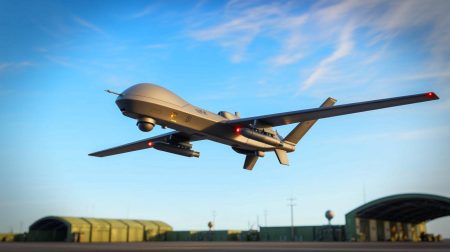| IN A NUTSHELL |
|
The United States is significantly enhancing its missile warning network with a strategic move involving global ground stations and unified software systems. This expansion aims to bolster national security by ensuring more resilient and expansive coverage for detecting missile launches. A crucial part of this initiative is the $244 million contract awarded to Northrop Grumman. This contract will facilitate the development of advanced relay ground stations both in the United States and the United Kingdom, marking a pivotal step in the evolution of America’s missile warning infrastructure.
Scalable Ground Systems for Evolving Threats
Northrop Grumman is at the forefront of developing scalable and upgradeable ground station designs. These designs are built upon the company’s substantial experience, particularly with the Relay Ground Station-Asia (RGS-A) currently under development in Guam. The new stations are designed to provide adaptable infrastructure capable of accommodating changes in satellite bandwidth and operational demands. According to Calvin Pennamon, Northrop Grumman’s director of operational exploitation systems, the ground systems are crafted to enhance communication between Space System Command’s legacy and future Space-Based Infrared Systems. This enhancement aims to provide access to multiple constellations, enabling warfighters to maintain a decisive edge against enemy threats. The Naval Information Warfare Center Pacific, acting on behalf of the Space Systems Command, selected Northrop Grumman for the multiple-award indefinite-delivery, indefinite-quantity (IDIQ) contract, emphasizing the trust placed in the company’s capabilities.
Strengthening the FORGE Modernization Framework
The ground stations are integral to the US Space Force’s (USSF) Future Operationally Resilient Ground Evolution (FORGE) system. This expansive effort is designed to upgrade and integrate U.S. missile warning capabilities. FORGE aims to establish a government-owned ground network that links both current and future missile detection satellites through modernized command and control operations. In addition to Northrop’s contract, the Space Systems Command has awarded $259 million to SciTec, a New Jersey-based software developer, to further FORGE’s integrated enterprise buildout. SciTec will develop a ground system supporting both FORGE and non-FORGE assets, enhancing continuity across legacy SBIRS and Next-Gen OPIR data pipelines. SciTec’s involvement is backed by previous contracts, including substantial awards for data processing tools and sensor processing applications, underscoring their essential role in this modernization effort.
S2E2 and ATLAS Systems Deepen Space-Based Defenses
As part of the broader modernization push, the USSF has activated the Survivable Endurable Evolution (S2E2) ground system. This system is designed to replace the aging 1960s-era Mobile Ground System, processing infrared data and integrating a nuclear detonation detection system. Additionally, L3Harris secured a contract in March to upgrade the Advanced Tracking and Launch Analysis System (ATLAS), which is crucial for monitoring anti-satellite activity and threats in orbit. These advancements underscore the USSF’s commitment to maintaining a robust and responsive space-based defense infrastructure. The integration of these systems is expected to enhance the United States’ ability to respond to emerging threats swiftly and effectively.
Global Coverage Through Distributed Relay Networks
The construction of new relay stations in the United States and the United Kingdom complements the ongoing development of RGS-A in Guam. This distributed network reinforces the USSF’s goal of achieving global, persistent missile warning capabilities. These relay hubs are designed to enable early-warning signals from infrared satellites to reach command networks and deployed forces more reliably. The Next-Gen OPIR program remains a cornerstone of the U.S. defense architecture, offering critical situational awareness and real-time missile launch detection to protect national and allied interests. The strategic placement of these stations ensures comprehensive coverage and enhances the reliability of the missile warning network.
As the United States continues to enhance its missile warning infrastructure through strategic investments and partnerships, the question remains: How will these advancements shape the future of global security and influence geopolitical dynamics in the coming decades?
Did you like it? 4.4/5 (28)










Great to see investments in national security. But are $244M and Northrop’s capabilities enough to ensure complete protection? 🤔
Why focus only on the U.S. and U.K.? Shouldn’t other allies be considered too?
Missile defense is crucial, but I wonder how this affects taxpayer money allocation for other areas. 🤷♂️
This is exciting news! Our defenses need all the upgrades they can get. 💪
Hope these stations will be operational soon. The threats aren’t waiting! 😬
Can someone explain how these upgrades compare to what other countries are doing?
Why can’t we use existing infrastructure? Seems like a huge waste of money.
Thank you for keeping us informed about these important developments. 👍
244 million dollars is a lot of money. I hope it’s worth it!
Are there any environmental impacts from building these stations? 🌍
It’s always Northrop! Do we have alternatives or is this a monopoly?
Do you think this will boost our global standing in defense capabilities?
I’m curious about how this system interacts with existing NATO defenses.
Great article, but where’s the info on how long this will take to implement?
Scalability is key! But what about cybersecurity? Are these systems secure? 🛡️
When will we see the first results of this investment?
As a taxpayer, I hope this investment is being made wisely!
Sounds like a step forward, but what does this mean for the average citizen?
Can these systems detect smaller, more agile threats?
Thank you Northrop for keeping us safe! 🙏
Will this contract create any new jobs in the U.S. or U.K.?
Are these stations vulnerable to cyberattacks? 😟
Shouldn’t we also focus on diplomatic solutions to reduce missile threats?
I’m glad to see we’re not cutting corners on defense.
Hope this partnership with the U.K. strengthens our military ties. 🇺🇸🇬🇧
Why is the contract so expensive? Seems like a lot of money! 😲